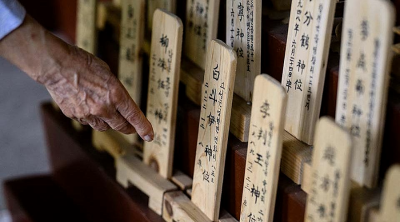
Portraits of the three North Korean leaders have been displayed side by side for the first time on the walls and in the classrooms of the Central Cadre Training School of the Workers’ Party of Korea, which was completed on May 21.
Kim Il Sung and Kim Jong Il were joined by a portrait of the Chairman of the State Affairs Commission Kim Jong Un.
It can be said that Kim Jong Un, who turned 40 this year, has shown off that he is completely on the same level as his grandfather and father.
Since October 2020, Kim Jong Un has not only been called “Suryeong (Supreme Leader)” like his grandfather and father, but in October 2022, a mosaic mural depicting Kim Jong Un appeared.
There is no doubt that a cult of personality has gradually developed around Kim Jong Un. However, the brakes have also been applied.
As Kim Jong Un himself said in March 2019, “Mystifying a leader’s revolutionary activity and appearance would result in covering the truth,” so the sense of speed is quite different from the personality cult that was implemented for Kim Jong Il.
Since the early 1980s, portraits of Kim Jong Il have been hung alongside those of Kim Il Sung in homes, factories, schools, train stations, and other places.
Since February 1992, his birthday has been designated the “nation’s most important holiday” and celebrated with great fanfare.
After Kim Il Sung’s death, North Koreans began singing the “Song of General Kim Jong Il” and wearing Kim Jong Il’s portrait badge.
Kim Jong Un, on the other hand, is already in his 13th year as ruler, but his birthday is not a public holiday, and even his year of birth has not been made public.
However, if the portraits of these three men become popular in society, the cult of personality will enter a new stage.
It will emphasise the dominance of the “Baekdu lineage” beginning with Kim Il Sung. Moreover, the fact that the portraits of the three men were placed side by side can be seen as a measure to prolong and perpetuate the system in order to pass it on to the fourth generation.
What is more difficult to interpret is that portraits of Marx and Lenin were hung on the other wall of the Central Cadres Training School.
In April 2012, shortly after the Kim Jong Un government took office, the giant portraits of Marx and Lenin that had been hanging in Kim Il Sung Square in central Pyongyang were removed. It was considered a manipulation of history as if the proponent of socialism was Kim Il Sung.
The “Juche (self-reliance) idea,” established as the guiding principle for the nation in the December 1972 constitutional amendment, was described as “a creative application of Marxism-Leninism to the reality of our country.”
In April 1992, however, references to “Marxism-Leninism” were removed from the constitution. The only way to avoid the consequences of the collapse of the Soviet Union and Eastern European socialist systems was to emphasise “our style of socialism.”
Nevertheless, the preamble to the constitution of the Workers’ Party of Korea still mentions only that “we will firmly uphold the revolutionary principles of Marxism-Leninism,” which does not mean that Marxism-Leninism is completely rejected.
Around the time of the 7th Congress of the Workers’ Party of Korea in May 2016, the Kim Jong Un government began to use the term “communism” frequently. With the domestic economy in dire straits and many people starving, Kim Jong Il removed the term “communism,” which means an ideal society, from the party constitution and constitution, and instead continued to refer to “socialism.”
However, as Kim Jong Un pursued party-centred state control similar to the era of Kim Il Sung, he returned to principles and began to speak of “communism.”
The revival of portraits of Marx and Lenin is not incomprehensible in this context.
However, Kim Jong Un was the one who took down the portraits of Marx and Lenin 12 years ago, and there is almost no rational reason why he would bring them back now. Rather, it seems to be simply a matter of the preferences or even the whims of individual leaders.
It is believed that Kim Jong Un attaches at least some importance to the political system and the policy-making process, as he frequently amends the party constitution and bylaws and holds frequent meetings.
Meanwhile, the parliamentary elections for the Supreme People’s Assembly, which were to be held in March 2024, have been postponed without explanation and no meetings have been held for a long time. This is despite the fact that not only was the election law significantly revised last August, but Kim Jong Un himself ordered a constitutional amendment in January 2024 to designate South Korea as an “unchangeable main enemy.”
Frequent changes in leadership are one example, but policies are often inconsistent.
It would be nice if the negative effects of concentrating too much power in one person did not affect diplomacy with neighbouring countries.

(Atsuhito Isozaki is Professor at Keio University, Japan.)
ADVERTISEMENT
ADVERTISEMENT








































